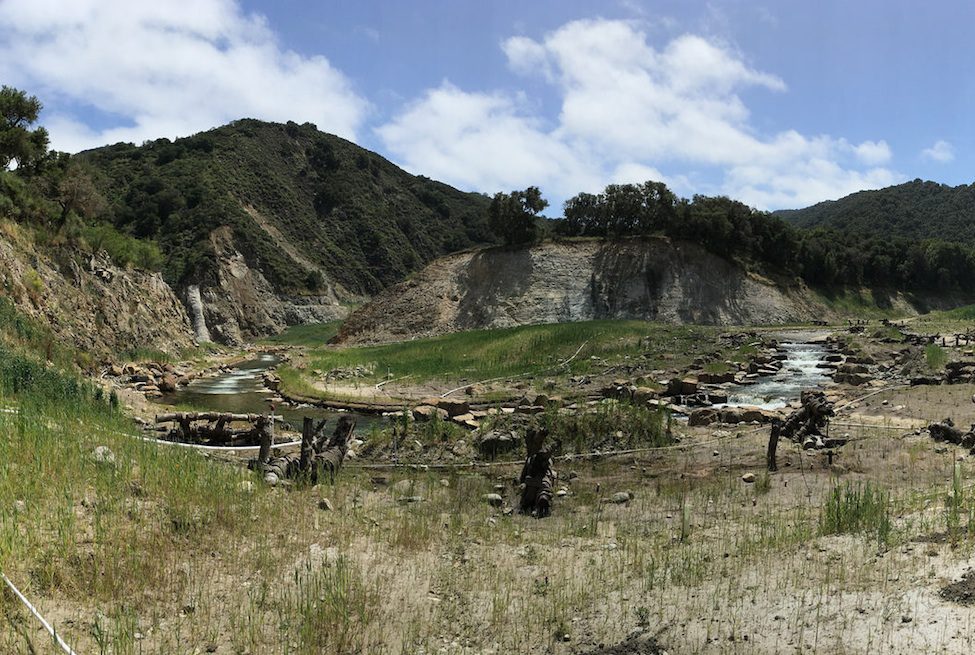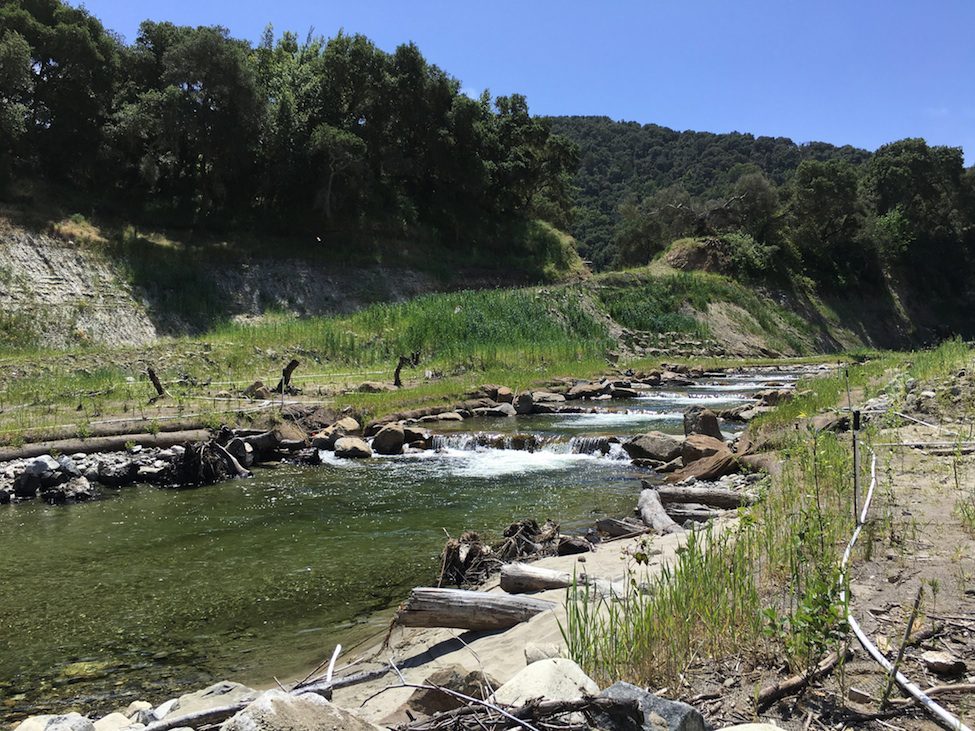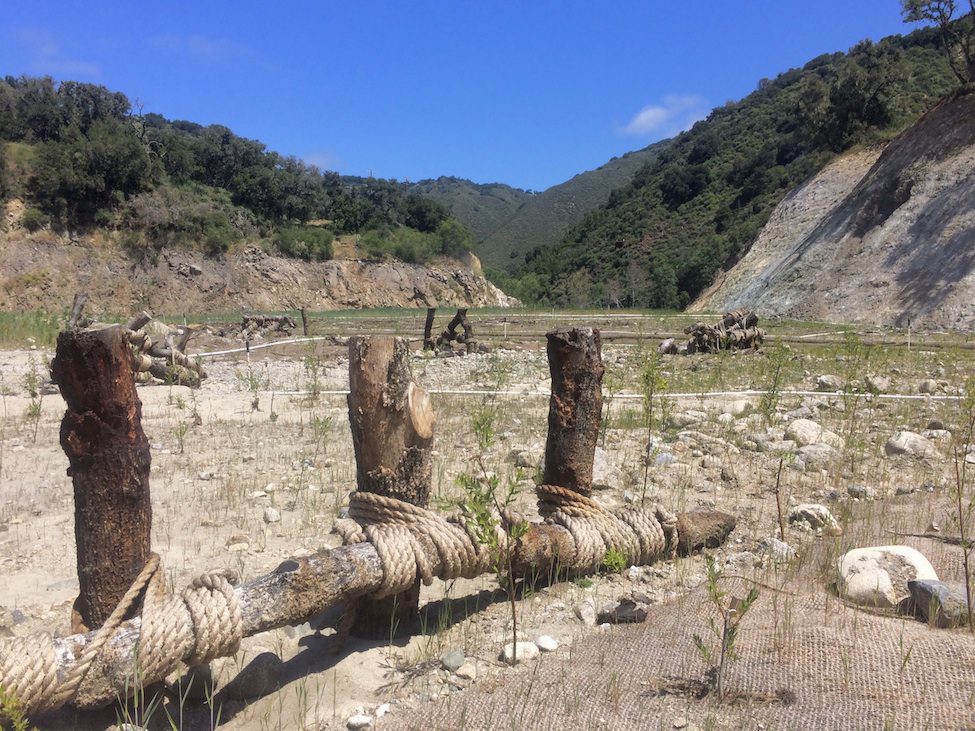Wednesday May 25, 2016
 It’s a rather surreal feeling to stand at the bottom of what was once a reservoir. Some our staff recently toured the restoration in progress at the removal site of the San Clemente Dam on the Carmel River, the largest dam removal in California history to date. We observed a flowing river and newly planted hillsides that were once submerged by sediment and water in the reservoir behind the dam. The dam had presented a number of challenges that prompted its removal, the biggest being that it was a safety hazard, as engineers had deemed the structure seismically unsound. The dam’s water storage capacity was also severely diminished by the estimated 2.5 million cubic yards of sediment that had built up behind it, and it posed a barrier to migrating steelhead. As part of removing the dam, the sediment behind it was stabilized in place, and the Carmel River was rerouted into neighboring San Clemente Creek for a half-mile stretch before flowing through the original dam location.
It’s a rather surreal feeling to stand at the bottom of what was once a reservoir. Some our staff recently toured the restoration in progress at the removal site of the San Clemente Dam on the Carmel River, the largest dam removal in California history to date. We observed a flowing river and newly planted hillsides that were once submerged by sediment and water in the reservoir behind the dam. The dam had presented a number of challenges that prompted its removal, the biggest being that it was a safety hazard, as engineers had deemed the structure seismically unsound. The dam’s water storage capacity was also severely diminished by the estimated 2.5 million cubic yards of sediment that had built up behind it, and it posed a barrier to migrating steelhead. As part of removing the dam, the sediment behind it was stabilized in place, and the Carmel River was rerouted into neighboring San Clemente Creek for a half-mile stretch before flowing through the original dam location.
 Our tour allowed us to see the new path of the Carmel River through the restoration area that was previously an arm of the dam’s reservoir. The river now flows through a series of sculpted pools arranged like steps in a gentle staircase. Two vertical white scars running up the hillsides serve as a landmark that helps envision where the 106-foot dam once stood. Project personnel leading the tour shared the amusing challenge of communicating with the construction engineers about how to make the restored hillsides as natural as possible – meaning they should be roughened and irregular, not perfectly straight and smooth like the side of a freeway. Orange poppies and purple lupine bloomed and nodded on these hillsides, which will now be able to weather with time. Steelhead have already been spotted in the restored river this year, and project personnel will be monitoring their spawning activity.
Our tour allowed us to see the new path of the Carmel River through the restoration area that was previously an arm of the dam’s reservoir. The river now flows through a series of sculpted pools arranged like steps in a gentle staircase. Two vertical white scars running up the hillsides serve as a landmark that helps envision where the 106-foot dam once stood. Project personnel leading the tour shared the amusing challenge of communicating with the construction engineers about how to make the restored hillsides as natural as possible – meaning they should be roughened and irregular, not perfectly straight and smooth like the side of a freeway. Orange poppies and purple lupine bloomed and nodded on these hillsides, which will now be able to weather with time. Steelhead have already been spotted in the restored river this year, and project personnel will be monitoring their spawning activity.
 Planting native riparian vegetation is a key step in restoring a functional floodplain ecosystem. To make sure the plants for the Carmel River restoration were both native and locally adapted, the team harvested seeds and saplings from the project area that were then grown in a nursery before planting on the restoration site. Healthy floodplains often exhibit a mix of both mature and young trees; however, starting a restoration from scratch meant that all of the newly planted trees were just the size of sticks. To help slow down the flow of water across the floodplain the way established trees do, the project partners created a variety of eye-catching structures they dubbed their “Pirates of the Caribbean” additions – collections of weathered tree trunks, stumps, and logs roped together like the components of a nautical obstacle course. Most of wood came from oak trees that were felled on the site during the project development, though some came from oaks from nearby areas that had died as a result of the drought and needed to be removed. These structures will help water stay on the floodplain so it can provide fish rearing habitat.
Planting native riparian vegetation is a key step in restoring a functional floodplain ecosystem. To make sure the plants for the Carmel River restoration were both native and locally adapted, the team harvested seeds and saplings from the project area that were then grown in a nursery before planting on the restoration site. Healthy floodplains often exhibit a mix of both mature and young trees; however, starting a restoration from scratch meant that all of the newly planted trees were just the size of sticks. To help slow down the flow of water across the floodplain the way established trees do, the project partners created a variety of eye-catching structures they dubbed their “Pirates of the Caribbean” additions – collections of weathered tree trunks, stumps, and logs roped together like the components of a nautical obstacle course. Most of wood came from oak trees that were felled on the site during the project development, though some came from oaks from nearby areas that had died as a result of the drought and needed to be removed. These structures will help water stay on the floodplain so it can provide fish rearing habitat.
This restoration can serve as a valuable learning experience and proof of concept for other similar projects in the future. The end product is undoubtedly satisfying for the various partners involved with the dam removal effort, which has been 17 years in the making. Monitoring of the restoration site will continue for the next five years. If you are interested in seeing the changes for yourself, the project website features a live web cam that visitors can also use to scroll back in time to watch how the restoration has progressed. Our staff are definitely keen to revisit the site a few years from now to witness the Carmel River’s continued transformation.
